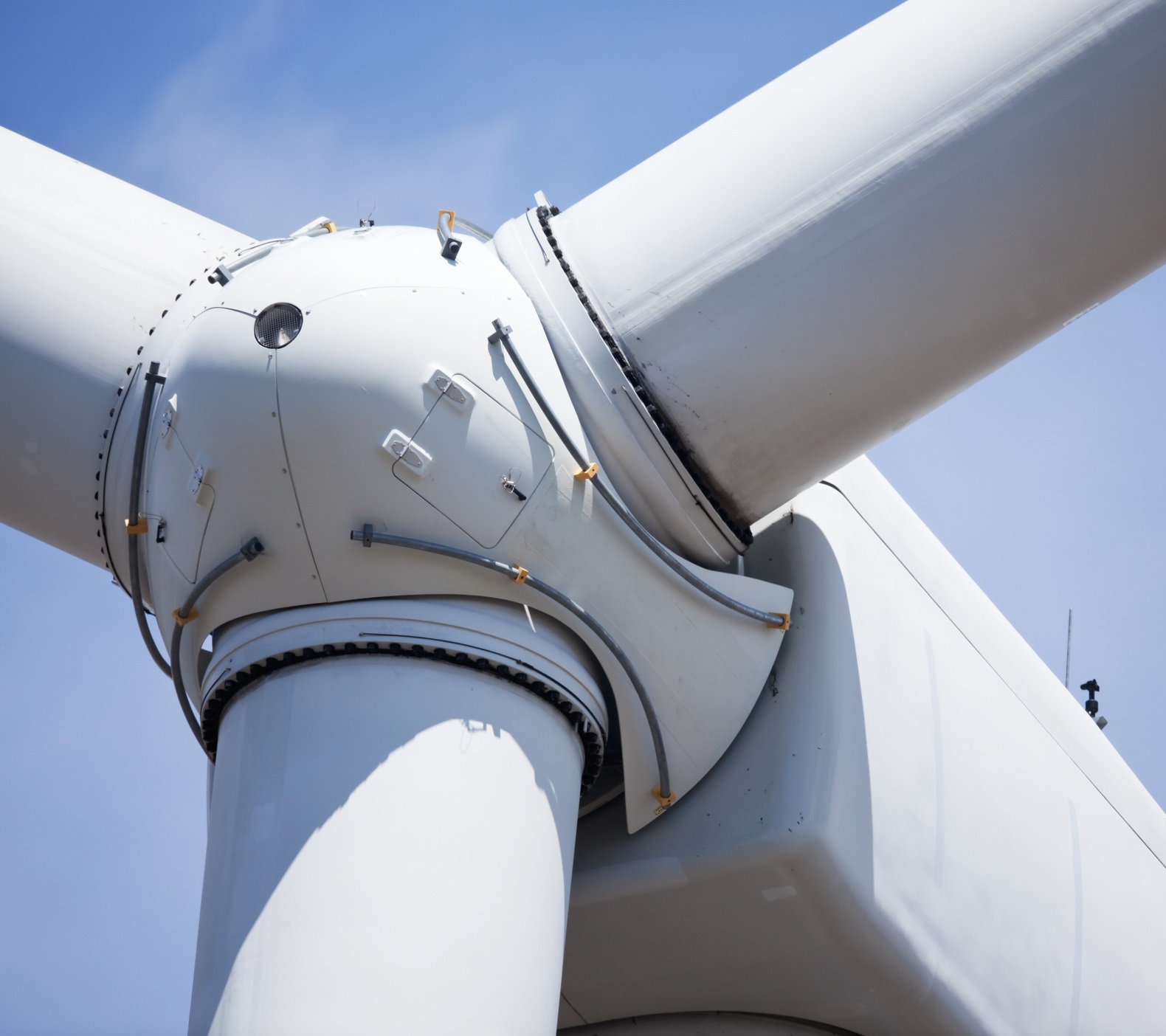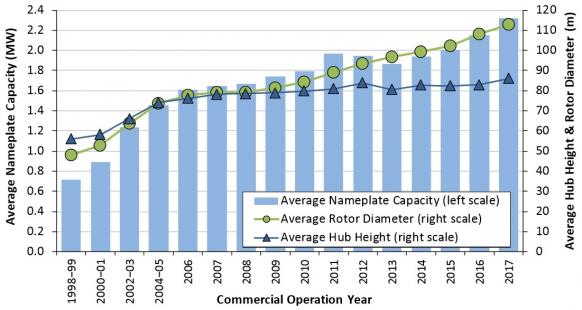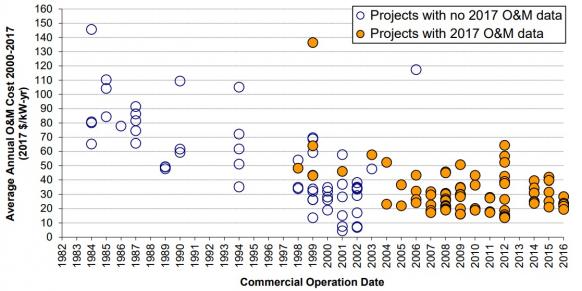Wind gearbox suppliers upgrade parts as larger units test reliability
Gearbox and bearings suppliers are using advanced modelling and analytics to improve designs and accelerate repairs as turbine sizes grow and cost pressures build.

Related Articles
The continuing drive towards lower wind costs raises significant challenges for gearbox efficiency and reliability.
Larger, higher efficiency turbines are putting increasing pressure on major plant components and raising the importance of turbine downtimes. GE recently unveiled a new 5.3 MW turbine which is more than double the average turbine capacity installed in the U.S. in 2017. The turbine incorporates 77-meter blades and raises annual energy production (AEP) by up to 50% compared with GE's 3 MW turbines, the company said.
An increasing focus on the levelized cost of energy (LCOE) has dented supplier margins and placed greater focus on longer lifespans. Many operators are extending turbine lifespans or repowering wind sites to maximize returns on investment.
Gearboxes remain a key source of asset failure, often due to bearing issues. A quarter of turbine gearboxes and generators need replacement within ten years of operation, IHS Markit said in a recent report.
Gearbox component suppliers and service companies are continuing to innovate to keep up with the latest turbine advancements.
Improved design modelling, new materials and better manufacturing processes are helping engineers to maximize the lifespan of gear systems, Jyrki Virtanen, Chief Technology Officer at Moventas, a gearbox system supplier, told New Energy Update.
“The better understanding we have of the nature of the loadings and especially dynamics of the loads, the better possibilities we have for modelling,” Virtanen said.
“The better materials we have in use, the more loads they can carry…meaning lighter gearboxes,” he said.
Gearbox designers are also optimizing up-tower strategies and using the latest analytics technology to lower fault risks.
Critical parts
Improved turbine system research and design standards have helped suppliers improve gear performance.
“Today there is a much better understanding of system level loads. Not only aerodynamic loads but also loads coming from the grid,” Virtanen said.
US average onshore turbine capacity, dimensions
(Click image to enlarge)
Source: Department of Energy's Wind Technologies Report (Berkeley Lab), August 2018.
An industry shift from single to multiple planetary gear designs has reduced the frequency of gearbox repairs.
Gearbox designs incorporate planet bearings so that the outer bearing ring is integrated into the inside diameter of the gear.
“This allows the designer to improve the load sharing within the multiple planet bearing rows and increases bearing capacity,” Doug Lucas, Advanced Engineering Technologist at Timken, a bearing and power transmission components supplier, said.
Some manufacturers are using smaller gearbox ratios and connecting to larger, lower speed generators to improve system reliability, he said.
These systems can be more difficult to access, making component reliability crucial.
“Planet bearings in the low speed stage have the highest loads, system deflections, and are the most difficult and expensive to replace, because replacement can involve removing the entire gearbox from the turbine,” Lucas said.
High speed shaft bearings located at the gearbox output are usually replaced more frequently but these are smaller and easier to replace up-tower.
Average US wind O&M costs 2000-2017
(Click image to enlarge)
Source: Lawrence Berkeley lab's Wind Technologies Report, August 2018.
Companies are also providing propriety service products to reduce gearbox repair times.
For example, Timken provides optimized bearing setting processes, preset bearings and special bearing designs.
"Optimized setting process and preset bearings reduce the variation in bearing clearance, which reduces stress and increases reliability,” Lucas said.
“Preset bearings will reduce up-tower bearing replacement time…Special bearing designs can be applied as upgrades to address known issues in the field,” he said.
For gearbox rebuilds, U.S. service group Gearbox Express redesigns planet bearing configurations to accept higher-precision integrated taper bearings, Bruce Neumiller, CEO of Gearbox Express said.
“This significantly increases the overall life of the gearbox. In most designs this is a 300%-400% increase in planet bearing rating,” he said.
Cost pressure
Despite growing industry expertise, the continuing drive towards lower wind capex costs could reduce long-term operational reliability, creating new challenges for operations and maintenance (O&M) teams, North American wind experts said at the Wind O&M Canada 2018 conference in November.
"We are cutting into the design margins, we are putting up equipment that is less costly but that could potentially have a longer term impact for those of us in operations," Ian MacRobbie, Vice President- Operations at Liberty Power, the renewable energy subsidiary of Algonquin Power & Utilities, said.
In some designs, basic manufacturing issues continue to create operational challenges.
Improper bearing fits in some new housing designs have increased risks from spinning bearings, Neumiller said.
Combined with increased runtimes, this has increased the number of housing repairs.
“This causes debris generation and can ultimately lead to gear failure due to misalignment from housing wear," Neumiller said.
Up-tower focus
Suppliers and service operators are also adapting designs and maintenance techniques to maximize the potential for up-tower repairs. By avoiding the removal of major equipment, companies can lower costs and increase energy availability.
Up-tower repairs help reduce crane costs, a key cost component of turbine maintenance. The latest high-capacity turbines require taller cranes which are often in limited supply.
GE's latest 5.3 MW turbine system incorporates a larger nacelle platform to facilitate up-tower repairs.
The machine is “specifically designed for services,” and is designed to facilitate up-tower repairs and troubleshooting using its up-tower electrical system, the company said.
“Today – as gearboxes have modular designs – it is possible to change a complete helical section or even planetary section of a gearbox up in the tower without the help of a big and expensive mobile crane,” Virtanen said.
“One customer is developing unique, proprietary up-tower repair strategies for main shaft bearings. This could increase the complexity of up-tower repairs, but it may result in lower costs and less time to repair the turbine,” he said.
Avoiding faults
The increasing use of predictive maintenance programs is helping prevent the escalation of possible gearbox problems, Virtanen said.
Analytics supplier Uptake recently installed its platform across MidAmerican’s entire 4.3 GW U.S. wind fleet.
The platform quickly detected bearing issues which could have forced a complete gearbox replacement.
"Within two days we found we had predictive insight on a main bearing failure that had it gone catastrophic, would have [cost] about $250,000, but because we are able to find it and send somebody up turbine, we could fix it before it happened at $5,000," Sonny Garg, Global Energy Lead at Uptake, told a webinar in 2017.
Proactive maintenance on key components like main bearings will help MidAmerican to reduce the need for emergency repairs and should have a significant impact on inventory costs, Mark Jeratowski, Maintenance Manager at MidAmerican, told the webinar.
"We are looking forward to a major reduction in inventory," he said.
By Neil Ford


